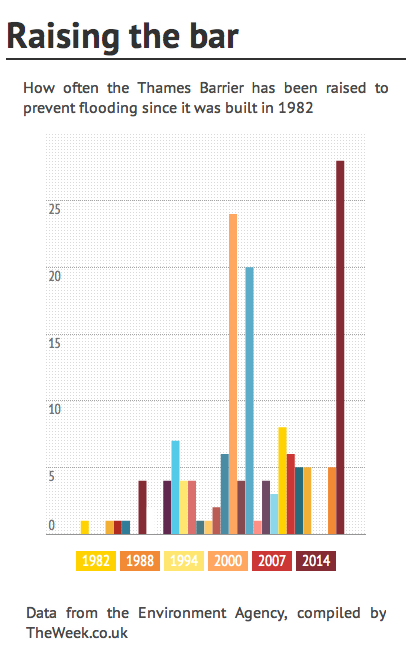Infographic: how often has the Thames Barrier been used?
The Thames Barrier has been raised 28 times in the last ten weeks – that's 20% of the total since it was built

SINCE it was built in 1982, the Thames Barrier has been raised 150 times in order to prevent flooding in central London. This year's wet winter has required it to be closed 28 times since December 6, accounting for 18.7 per cent of the total closures in its 32-year history.

The Environment Agency recently released the map below showing how much of London would be under water if it were not protected by the Thames Barrier.

A free daily email with the biggest news stories of the day – and the best features from TheWeek.com
The Week
Escape your echo chamber. Get the facts behind the news, plus analysis from multiple perspectives.

Sign up for The Week's Free Newsletters
From our morning news briefing to a weekly Good News Newsletter, get the best of The Week delivered directly to your inbox.
From our morning news briefing to a weekly Good News Newsletter, get the best of The Week delivered directly to your inbox.
-
 The best tabloid stories of 2025
The best tabloid stories of 2025In the Spotlight From a child named after the devil to a pothole-based theme park, some strange stories hit the headlines this year
-
 7 bars with comforting cocktails and great hospitality
7 bars with comforting cocktails and great hospitalitythe week recommends Winter is a fine time for going out and drinking up
-
 7 recipes that meet you wherever you are during winter
7 recipes that meet you wherever you are during winterthe week recommends Low-key January and decadent holiday eating are all accounted for
-
 Death toll from Southeast Asia storms tops 1,000
Death toll from Southeast Asia storms tops 1,000speed read Catastrophic floods and landslides have struck Sri Lanka, Indonesia, Thailand and Malaysia
-
 Cloudbursts: what are the 'rain bombs' hitting India and Pakistan?
Cloudbursts: what are the 'rain bombs' hitting India and Pakistan?The Explainer The sudden and intense weather event is almost impossible to forecast and often leads to deadly flash-flooding and landslides
-
 FEMA Urban Search and Rescue chief resigns
FEMA Urban Search and Rescue chief resignsSpeed Read Ken Pagurek has left the organization, citing 'chaos'
-
 Why are flash floods in Texas so deadly?
Why are flash floods in Texas so deadly?Today's Big Question Over 100 people, including 27 girls at a summer camp, died in recent flooding
-
 Search for survivors continues after Texas floods
Search for survivors continues after Texas floodsSpeed Read A total of 82 people are confirmed dead, including 28 children
-
 Parts of California are sinking and affecting sea level
Parts of California are sinking and affecting sea levelUnder the radar Climate change is bringing the land to the sea
-
 At least 95 dead in Spain flash floods
At least 95 dead in Spain flash floodsSpeed Read Torrential rainfall caused the country's worst flooding since 1996
-
 Colombo's wetlands: how the 'lungs' of Sri Lanka's capital are being restored
Colombo's wetlands: how the 'lungs' of Sri Lanka's capital are being restoredUnder the radar The revival of the ecosystems could prove a 'valuable lesson' for the world